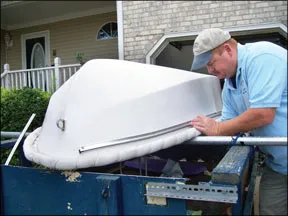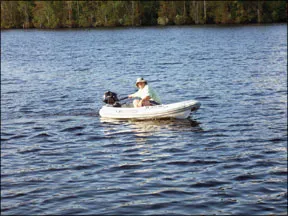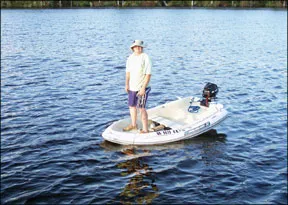It started out as a Socratic quest for truth and knowledge (to satisfy that itching curiosity)-a yearning in the cockles (or maybe the sub-cockles) of one Practical Sailor testers brain to not only determine whether it could be done, but if it should be done. Were talking about the non-standard installation of a Walker Bay tube kit on an older fiberglass dinghy.

The family dinghy, an 8-foot Dyer knock-off acquired in the late 1980s, was the perfect tender. But two kids and a dog later, and the family dink no longer fit the family-particularly with the added weight of a four-stroke, 3.5-horsepower outboard clamped on the stern. Our tester was accustomed to the benefits of a hard dinghy-durability, the ability to sail it, superior rowing-but lusted after the increased stability and carrying capacity of an inflatable.
A rigid-hull inflatable seemed to offer the best of both worlds, but the prices were out of this world. Besides, the old dinghy was still in great shape, so dropping the cash for an expensive new dinghy was unjustified. (Whats a tightwad sailor to do?) And thats how the idea for a DIY hybrid dinghy was born: We would make the old dink new with the addition of the inflatable tube from a Walker Bay RID (Ridged Inflatable Dinghy).
Walker Bay dinghies can be retrofitted with a tube kit to increase stability and carrying capacity. The measurements of the 8-foot Walker Bay RID and the testers old dinghy are similar, so making the leap to install the tubes on the testers dink was an obvious choice. (We reviewed the 9-foot RID in the Nov. 1, 2003 issue and used a tube-fitted RID in the small outboards test in the December 2006 issue.)
The first step was verifying that the installation was physically possible, followed closely by price comparisons to determine whether it made sense to do so money-wise.
The Walker Bay RID tube kit for its 8-foot dinghy comes in two models, the 275R with PVC tubes and the 275H, which has Hypalon tubes. Each kit contains the tube-a single “U” shaped affair with four separate air chambers-plus four sections of pre-drilled aluminum mounting track, a tube/valve repair kit, and installation hardware needed to install the tube on a Walker Bay dinghy.
Mounting the tubes on a Walker Bay dinghy is a straightforward procedure, particularly those models where the hull has been pre-drilled to accept the tube mounting tracks. The kit also includes instructions and patterns for drilling and mounting the tracks and tubes on non-RID-ready Walker Bay dinghies (a plus for our particular project). Once the tracks are mounted to the hull, the tube is then fed into the track, from the bow to the stern.

After comparing more precise measurements of the Walker Bay and the testers dinghy, we concluded the installation was doable; however, because the Walker Bay has a finer bow, the pre-bent tube mounting tracks would require some minor tweaking to fit the more rounded bow of the older dinghy. To be sure some subtle detail wasnt being overlooked, the plan was floated by the folks at Walker Bay for suggestions.
It soon became apparent that no one there had really given the idea much thought-not surprising, as the tube kits are designed specifically for use with dinghies built by Walker Bay, who is after all in the business of selling dinghies, not accessories for other manufacturers. After conversations with a number of representatives, the final word was that while it could likely be done, it wasnt recommended. This was mainly due to the track modifications required (which a buyer may or may not be able to complete correctly) and the wide variety of hull shapes out there that folks may try to stick them on. The tube kits one-year warranty is voided if its installed on anything other than a Walker Bay boat.
According to Brigitta Shore, Walker Bays media relations specialist, “Walker Bay Boats cannot guarantee their product if it is not used for the intended purpose. In this case, the tubes kits are built to fit Walker Bays boats, a custom manufactured product. If they are used for any other purpose, the warranty is void. The reason is that hull shapes differ, as do their materials, which can cause strains, wrinkles, and stresses.”
Walker Bay vs. Dinghy Dogs
Next up was a price-check comparing the various purchase options. Both the PVC and Hypalon Walker Bay tube kits are available from West Marine. The 275R PVC tube kit is roughly $860, while the 275H Hypalon tube kit runs $1,200. This difference in price is primarily due to Hypalons touted superior resistance to UV degradation. While both materials are advertised as being rugged and durable, Hypalon is recommended for use in warmer climates, bearing in mind warmer doesn’t necessarily mean tropical. Walker Bay recommended Hypalon for use in our testers home port of Chesapeake, Va.
A quick Internet search showed that rigid-hulled inflatables in the 8-foot range with Hypalon tubes start out around $3,000. Buying a Walker Bay 8-foot dinghy ($750) and the 275H tube kit totaled approximately $1,950. By comparison, our test dinghy could be upgraded for the cost of the 275H kit alone, a savings of $750 to $1,800, depending on the option chosen.
There was another option that warranted consideration: Dinghy Dogs, two separate tubes that attach to the port and starboard side of your hard dinghy. According to the companys website, construction consists of an inner bladder of 10-mil polyurethane fabric with an outer covering of “super tough polyester-reinforced vinyl fabric with UV inhibitors.” Practical Sailor editors tested out the Dinghy Dogs when they were first born (December 1993). The conclusion was that they increased stability without interfering with rowing, but with a loaded tender, they likely would increase drag.

When considering the Dinghy Dogs, two immediate benefits stood out: the price (approximately $400) and ease of installation-as the tubes are separate, they can easily be mounted on most any hard dinghy, regardless of bow shape.
In the end, the decision to go with the Walker Bay tube instead of Dinghy Dogs was based mainly on aesthetics and construction materials choice. Our tester preferred the look of the one-piece tube and the Hypalon material.
The Installation
The installation instructions for the Walker Bay tube kit were thorough and helpful. We particularly found the section on retrofitting non-RID-ready boats to be useful for our project. The crucial part of the installation was proper placement of the track assemblies to ensure the tubes both looked and performed correctly.
Our install involved more than a typical installation on a Walker Bay dinghy would require, as the provided template-not surprisingly-didnt work with our test dinghy. However, the added steps-taking additional measurements and bending the tracks to better fit the bow of our test dinghy-were relatively simple, and within the ability of most do-it-yourself sailors.
The Results
Installing the tube kit provided a huge increase in the stability of the fiberglass dinghy, thereby increasing the safe load-carrying capacity. The tube also looks good and provides additional protection to the topsides of the mother ship when the dinghy is tied alongside.
All in all, our tester was more than pleased with the results. The installation worked well in this situation, but any other sailors looking to accomplish this DIY project should weigh each option carefully before taking on the retrofit.









































Hi,
Nicely written piece about the retrofit. I have a question: Do you have any suggestions on how one could attach the WB 8′ tube (old style) onto the WB dinghy, using a different attachment as I do not have the rails it came with?
Any thoughts, suggestions would be appreciated.
Thank you kindly.
Matt Quade (Milwaukee)
mattlq@yahoo.com